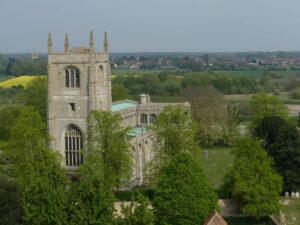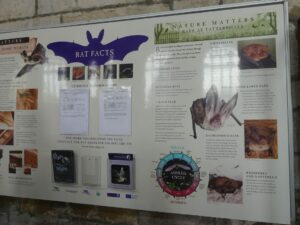 On a summer’s evening, the grand medieval building of Holy Trinity Collegiate Church in the pretty village of Tattershall in Lincolnshire comes alive. Hundreds of tiny, furry brown soprano pipistrelle bats swoop and swirl inside the church before slipping out through a small gap above a heavy gothic door into the surrounding countryside in search of insects to eat.
On a summer’s evening, the grand medieval building of Holy Trinity Collegiate Church in the pretty village of Tattershall in Lincolnshire comes alive. Hundreds of tiny, furry brown soprano pipistrelle bats swoop and swirl inside the church before slipping out through a small gap above a heavy gothic door into the surrounding countryside in search of insects to eat.
This 15th century church is vital for bats, with no other place in the county known to support as many species. Alongside the breeding population of soprano pips, Daubenton’s bats, known as ‘water bats’ for their feeding habits of skimming across water catching insect prey, also breed within the building. At times, it can host up to seven different species of bats, to say nothing of the other wildlife using the church including nesting birds and the wood-boring death watch beetle.
But there’s another aspect of Tattershall church that makes it so notable, and that’s the harmonious coexistence of its resident wildlife and the church community despite the challenges posed by the bats. The congregation has created an excellent partnership with its local bat group and runs bat-themed activities and events throughout the year, using its wildlife to engage visitors and reach new audiences.
These winged nocturnal mammals provoke a range of reactions, from fear and revulsion due to their association with darkness, disease and the mythological underworld, to curiosity, affection and an admiration bordering upon awe. Bats have more in common with us humans than we perhaps realise, although they’re often thought of as closer to rodents than homo sapiens, in fact bat skeletons and human skeletons are not so dissimilar. Excluding, of course, the long ‘fingers’ that make up the structure of bats’ wings.
Like us humans, bats are sociable creatures who roost together for company and comfort, are relatively long-lived for their size, and have a similar slow reproductive strategy, birthing just one pup a year which is nipple-fed and nurtured by its mother until ready to quite literally fly the roost.
But even with all their charms, bats create a big cleaning burden for the church community. Until recently it was difficult for churches to access any kind of practical help with their bat populations, despite the fact that research from the 1990s estimated some 60% of pre-16th Century churches house bats, and the true figure is thought to be much higher.
 As a threatened species, vulnerable to habitat decline, bats and their roosts are protected by law. When they take refuge in churches, drawn no doubt to the range of microclimates and roosting opportunities offered by complex and porous buildings, not to mention churchyards rich in biodiversity and usually linked to wider natural ‘corridors’, they must not be removed or interfered with in any way. This has implications not just for the day to day operation of churches but also for maintenance and larger capital works projects, which must be carried out only under a licence.
As a threatened species, vulnerable to habitat decline, bats and their roosts are protected by law. When they take refuge in churches, drawn no doubt to the range of microclimates and roosting opportunities offered by complex and porous buildings, not to mention churchyards rich in biodiversity and usually linked to wider natural ‘corridors’, they must not be removed or interfered with in any way. This has implications not just for the day to day operation of churches but also for maintenance and larger capital works projects, which must be carried out only under a licence.
The Bats in Churches Project was set up in 2018 to respond to the needs of churches like Tattershall. A five-year partnership between the Church of England, Churches Conservation Trust, Bat Conservation Trust, Natural England and Historic England, the project helps church communities live with and find solutions to the challenges posed by their resident bats. Working with more than 100 of the worst affected churches across England, the project connects bat ecologists, church architects, heritage specialists, bat groups and church communities to create bespoke solutions to the range of issues posed by bats.
This could be as simple as practical help with the cleaning burden – bats, after all, aren’t church-trained and their droppings and urine are messy and can cause damage to historic monuments, artefacts and the interior fabric of the church. In other cases, this could involve extensive capital works projects carried out under the new Bats in Churches Class Licence to help separate the bats from the congregation or alter how they access the church.
Ultimately Bats in Churches exists to help find solutions to human-wildlife conflict that take into consideration the needs of all parties. Often solutions are bespoke, tailored to the unique location, fabric, history and bat colony of that particular church. And always, solutions don’t prioritise the needs of one party over another. Some degree of compromise will inevitably feature, and there is a need not only to find practical solutions but also to help congregations educate themselves, and their wider communities, around bats.
As in the case of Tattershall church, many church communities already recognise the benefits that bats bring and that having protected wildlife living within churches can help attract new audiences and deepen links to the local community, through school visits, bat events and church fairs.
Bats in Churches is also running an ambitious citizen science project to understand more about how and why bats are using, or not using, churches. The information gathered by this project will help inform future work around bats in churches, and act as a legacy once the project concludes in 2023. It’s important we survey as many churches as possible and for this, we need help! We encourage everybody to sign up to survey their local church, no experience is needed. You can sign up at batsinchurches.org.uk.
Cathy Wallace, Bats in Churches Project


 On a summer’s evening, the grand medieval building of Holy Trinity Collegiate Church in the pretty village of Tattershall in Lincolnshire comes alive. Hundreds of tiny, furry brown soprano pipistrelle bats swoop and swirl inside the church before slipping out through a small gap above a heavy gothic door into the surrounding countryside in search of insects to eat.
On a summer’s evening, the grand medieval building of Holy Trinity Collegiate Church in the pretty village of Tattershall in Lincolnshire comes alive. Hundreds of tiny, furry brown soprano pipistrelle bats swoop and swirl inside the church before slipping out through a small gap above a heavy gothic door into the surrounding countryside in search of insects to eat. As a threatened species, vulnerable to habitat decline, bats and their roosts are protected by law. When they take refuge in churches, drawn no doubt to the range of microclimates and roosting opportunities offered by complex and porous buildings, not to mention churchyards rich in biodiversity and usually linked to wider natural ‘corridors’, they must not be removed or interfered with in any way. This has implications not just for the day to day operation of churches but also for maintenance and larger capital works projects, which must be carried out only under a licence.
As a threatened species, vulnerable to habitat decline, bats and their roosts are protected by law. When they take refuge in churches, drawn no doubt to the range of microclimates and roosting opportunities offered by complex and porous buildings, not to mention churchyards rich in biodiversity and usually linked to wider natural ‘corridors’, they must not be removed or interfered with in any way. This has implications not just for the day to day operation of churches but also for maintenance and larger capital works projects, which must be carried out only under a licence.